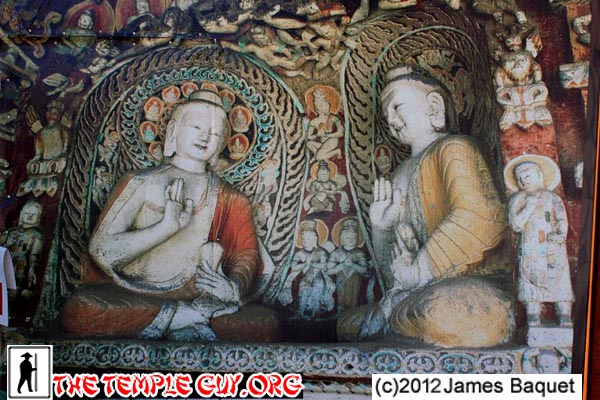(1) One of Datong's major attractions, the carved caves at Yngang Grotoes were mostly created before 494 CE, making them China's first such grottoes. Recently, a huge amount of money has been spent to surround the modest grottoes with colossal accompaniment (thus justifying the outrageous 150rmb entrance fee).
(2) One of the new additions is Ling Yan Si, a temple with some unique features. One is that it sits on an island, as seen here.
(3) Another is that the statues, although made of wood, emulate those in the Grottoes.
(4) There is also a pretty well-done new pagoda in the center of the temple.
(5) Looking toward the Grottoes, you can see part of an ancient wall. Watchtowers of the Great Wall dot the area, and there's a Qing Dynasty fort on the plateau above the Grottoes.
(6) This is Tan Yao (曇曜) who created the first five caves. They are similar in style, and the Buddhas in them use the faces of the Imperial Family of the time.
(7) Most looked like this: a window above (where the digging started), and a door below. The window creates a sort of "special effect," lighting the face more than the body of the Buddha.
(8) Here's the view of one statue when one steps into the cave.
(9) The front of this cave collapsed, exposing this fellow to the elements. It has thus become the most-photographed symbol of the Grottoes.
(10) Some of the Grottoes have central columns carved to look like pagodas.
(11) The walls of these "pagoda caves" may also be carved. Many were painted.
(12) Alas, the ones who got away: The most ornately-painted of the caves were closed for repairs; this is a picture of a picture of one of the more famous pairs of figures.
(13) This is the first Big Buddha I saw. The holes were once occupied by wooden pegs, used to hold a plaster covering that was then painted.
(14) This Buddha has some of his paint intact.
(15) Some of the figures have deteriorated in ways that made them look creepy.
(16) Originally, all the caves had these buildings in front of them; there seems to be a plan afoot to restore them. Inside one of these was one of the most amazing rooms I've ever been in.
(17) Even the wooden entry way was almost overwhelmingly beautiful.
(18) In the center was a huge, square column, entirely carved, as well as the walls. Pictures can't come close to doing justice. I just stood there in awe, for minutes; no place I've ever been has affected me as this did.
(19) The ceiling of another cave.
(20) These figures are Hindu gods, carved into opposite sides of an archway: "Kumara" (Murugan) on a peacock (left) and "Maheshvara" (Shiva) on bull (right). Each has multiple implements in his hands, and celestial beings above.
(21) All of the cave interiors were "no photo" zones. The helpful young man at the bottom right roused himself long enough to say "no photo" before falling back asleep. I was far from the only one breaking the rules--even on-staff tour guides were shooting their guests in front of the carvings!
(22) These guys were working on a documentary with a boom camera.
(23) Remains of a watchtower on one of the many "Great Walls" (there wasn't just one), visible from the grounds of the Grottoes.
| ← Previous Site | Back to Trip 19 Introduction | Next Site → |
Last Updated August 21, 2019
























No comments:
Post a Comment